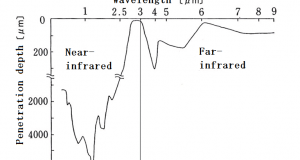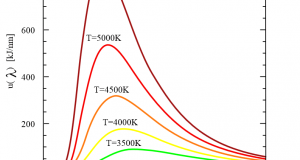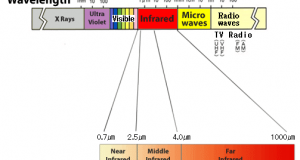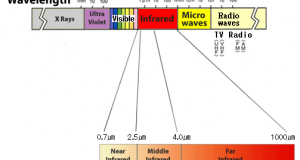Thermal properties of various substances Material-Metal Reference temperature [℃] Density [g/cm3] Specific heat [J/g ℃] Thermal conductivity [W/m K] Zinc 20 7.13 0.383 113 Aluminum 20 2.7 0.9 204 Aluminum oxide 20 3.9 0.875 30 Duralumin 20 2.79 0.84 164 ...
Read More »9. Attention in the infrared rays use (Q&A)
(Q) Can heat in the far-infrared rays metal? (A) Since there is a lot of metal electrons, it reflects the electromagnetic waves (far-infrared rays) in general. The good conductivity metal such as gold and aluminum, it is hard to heating ...
Read More »8. Comparison of far-infrared rays and near-infrared rays
(1) Infrared Rays are subdivided into several scheme. ISO 20473 specifies the following scheme: Designation Abbreviation Wavelength Near-Infrared NIR 0.78–3 µm Mid-Infrared MIR 3–50 µm Far-Infrared FIR 50–1000 µm (2) Difference in frequency = The difference between the heating capacity By “Wien’s displacement ...
Read More »7. Generation of far-infrared rays
The method of heating the ceramic to make a far-infrared artificially is common. The fine ceramics of an alumina system or a zirconium system are used well. Wavelength and the emittance change by a kind and the heating temperature of ...
Read More »6. Absorption rate of infrared rays
【 Infrared Absorption Rate 】 Please confirm the index of absorption of infrared rays in this table. The material absorbed by about 0.5 = 50% or more is suitable for the infrared heating.
Read More »5. 4 basic laws about radiation
1.Planck Radiation Law Max Karl Ernst Ludwig Planck, FRS (23 April 1858 – 4 October 1947) Planck’s law describes the electromagnetic radiation emitted by a black body in thermal equilibrium at a definite temperature. The law is named after Max ...
Read More »4. About heating
The thermal energy transfer from higher temperature to lower temperature. Transfer of the thermal energy , there are three principles, Conduction, Convection, and Radiation. In an actual situation, transfer of the thermal energy is performed in the form these three ...
Read More »3. Type of the infrared rays
Infrared Rays are subdivided into several scheme. ISO 20473 specifies the following scheme: Designation Abbreviation Wavelength Near-Infrared NIR 0.78–3 µm Mid-Infrared MIR 3–50 µm Far-Infrared FIR 50–1000 µm The International Commission on Illumination (CIE) recommended the division of infrared radiation into the following ...
Read More »2. About infrared rays
Although it is not visible, because the light with the power which warms a thing existed “outside red”, it was named “infrared rays.” Infrared rays are the same “Electromagnetic waves” as “X-rays”, “Ultraviolet rays”, “Visible light”, “Microwave”, “Radiofrequency wave”, etc. ...
Read More »1. The discovery of the infrared rays
<Science of the Infrared rays -INDEX- > 1. The discovery of the infrared rays 2. About infrared rays 3. Type of the infrared rays 4. About heating 5. 4 basic laws about radiation 6. Absorption rate of infrared rays 7. ...
Read More » HEAT-TECH Best Technology Online Shop
HEAT-TECH Best Technology Online Shop 








